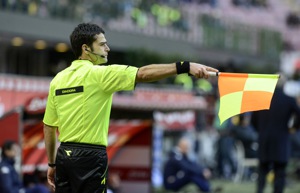What is the Offside Rule in Football?

Paolo Bona / Shutterstock.com
The offside rule in football is one of the most misunderstood rules in any sport. Offside decisions, whether right or wrong, have the ability to affect a team’s entire season, which makes them a big talking point after many matches.
The Purpose of the Offside Rule in Football
The key to understanding what the offside rule is in football is to understand why it was first brought in. The purpose of the law is to prevent what is colloquially called ‘goal-hanging’ or 'cherry-picking'.
This tactic (still used in informal games in school playgrounds and across the world's recreational pitches) involves the striker permanently being stationed near the opposition goal waiting for a long ball forward. Games without an offside rule, therefore, degenerate into each team hitting long balls to their striker, which is not very entertaining for spectators.
The Offside Rule Explained
A player is offside when they are in a position that is closer to their opponent’s goal line than both the second to last opponent and the ball. However, they are not classed as being offside if:
- They are in their own half
- They are level with the second to last opponent or the last two opponents
- They receive the ball directly from a corner, goal-kick or throw-in
The player in an offside position is only penalised if at the moment the ball is played, in the view of the referee, he is actively involved in play. This can be by:
- Gaining an advantage from that position
- Interfering with an opponent
- Interfering with play
What Happens In the Event of an Offside Offence?
When an offside offence has been identified, the referee blows their whistle to immediately pause the game. The referee will then award an indirect free kick to the opposing team that has to be taken from the place where the infringement occurred.
The Officials Used in Enforcing the Offside Rule
The referee depends a great deal on their assistant referees to enforce the offside rule. Stationed on the sidelines, they keep in line with the ball or the second to last opponent and signal to the referee if they think an offside offence has been committed. What many people don’t realise is that the angle of their flag signals the approximate location of the offence:
- 45 degrees down: The offence occurred in the third of the pitch nearest to the assistant referee
- Parallel to the ground: The offence occurred in the middle third of the pitch
- 45 degrees upwards: The offence occurred in the final third of the pitch
What is the Offside Trap?
The offside trap is a playing style that was originally pioneered by Arsenal FC in the early 20th century. It is when the defenders of a team move upfield in a line as a unit just moments before the opposition play a through ball. This, in theory, should leave the attacker isolated and offside. However, it is a risky tactic and one that can go badly wrong if not implemented correctly.